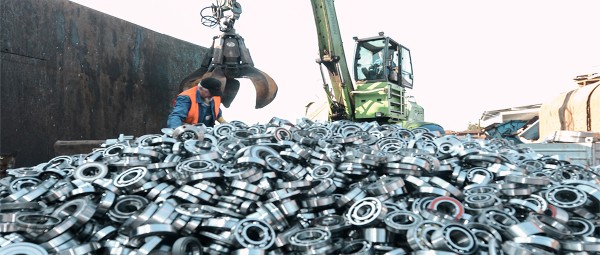The true value of authenticity
With access to sophisticated copying, printing and packaging technologies, counterfeiters are making it more difficult than ever to recognise fake bearings. To counter this, bearing manufacturers are implementing even more sophisticated methods of detection, says Aswerd Gresel, Schaeffler UK’s Bearing & Industrial Solutions Manager, UK and Ireland.
Counterfeit products can be extremely deceptive these days, not only in resembling the original product itself, but also how they are boxed. External packaging can look identical, the colour match and bearing markings may look perfect, with even holograms being indistinguishable from the original. They go as far as to ensure the security tape and internal packaging can look convincing.
Whilst the quality of fake bearings and their packaging can be visually exceptional, the internal engineering of the bearing and the materials used, is significantly inferior to the original. A counterfeit bearing is likely to suffer from design flaws such as dimensional inaccuracies, excessive clearance, higher noise and vibration levels, as well as a reduced load rating.

High price to pay
What might the consequences of a counterfeit bearing be?
At the very least, a reduced and unpredictable service life resulting in increased maintenance costs. When used in critical applications, the product may fail within a short time, causing unforeseen, costly downtime. In the worst case, a counterfeit product can even result in danger to life. Imagine counterfeit bearings installed in a hospital’s emergency power supply system that fail or in a truck carrying urgently needed supplies.
With more sophisticated copying, printing and packaging methods, detailed knowledge is required in order to safely and quickly distinguish between an original and a counterfeit bearing. Experienced, attentive bearing installers may be able to detect counterfeits, with some reporting that the fake product “felt strange when touched” or “somewhat different” to the products they had installed in the past. However, for inexperienced installers, recognising a counterfeit is getting much more challenging.
A growing problem?

Counterfeiting is big business with those involved prepared to make big investments. They have the advantage of not incurring any R&D costs. The only thing they need to invest in is the copying. Whilst there are no publicly available statistics on the size of the UK market for counterfeit bearings, it’s definitely happening here and across many parts of Europe. Amsterdam airport, for example, is a busy airport that has been used as a hub for counterfeit products. In the last few years, shipments of counterfeit products were seized by customs at the airport, which included fake bearings supplied from India, China and Vietnam. Even larger sized bearings are being copied. Counterfeit bearings for wind turbines were also found at a repairer’s premises in The Netherlands recently.
In the past, counterfeiters would clean, polish and lubricate used bearings and sell them ‘as new’ on the black market. This is no longer the case. Counterfeiters now machine completely new bearings as they have the technology to do this. They also make an almost perfect match of the packaging, with the manufacturer’s logo that looks identical. There are some tell-tale signs when it’s a fake, for example, the type of cardboard may be slightly different or the label may be placed in the wrong position on the box.
Protecting authenticity
There are almost certainly counterfeiters operating in the UK, perhaps not manufacturing counterfeits, but trading them. In the world of piracy, particularly in recent years since parting from the EU, the UK has become one of the bigger hubs for trading fake products. Tackling the problem starts with awareness. As manufacturers, distributors and other stakeholders – we need to be aware that fake products do exist. Second, as a buyer, ensure that you always buy direct from the bearings manufacturer or through a Distribution partner.
A counterfeit part frequently implies significant damage to a brand’s image and lost sales for that company. Since it was established in 2004, Schaeffler’s Brand Protection Team has successfully handled several thousand counterfeit cases. The team has developed and implemented a comprehensive brand protection strategy with legal, organisational and public relations measures that are constantly refined. Removing counterfeits from the market is the primary goal, protecting the customer, raise awareness of the issue, supporting customers and certified retailers in detecting counterfeits and assisting the authorities.


Schaeffler places labels with a unique data matrix code, which is near impossible to copy, on all its bearing labels, allowing them to be checked by smartphone using the Schaeffler OriginCheck app. This puts our customers in an even better position to purchase original parts from safe sources. The team also conducts its own investigations worldwide – including online monitoring activities on B2B or B2C platforms, trade fair visits, internet research and test purchases. Close cooperation within the entire sales network is critical, as well as the authorities and customs.
Future concerns
We have previously celebrated the benefits of additive manufacturing and how it can support the manufacturing process, however, with the emergence of 3D printing technologies counterfeiters are helped to produce fakes that closely resemble the original, more than ever before.
The concern is that counterfeiters could send a detailed bearing design digitally over the internet, from anywhere in the world, to a UK-based counterfeiter, who could then 3D print the bearing and sell it in the local market. The counterfeiters would not even need to worry about fakes being seized by customs, as they are produced in the country where they are sold. 3D printers are currently limited in terms of the volumes and speed at which they can produce parts, as well as limits on the size of the part itself, though as the technology is advancing at a rapid pace, so does the concern for the future.
